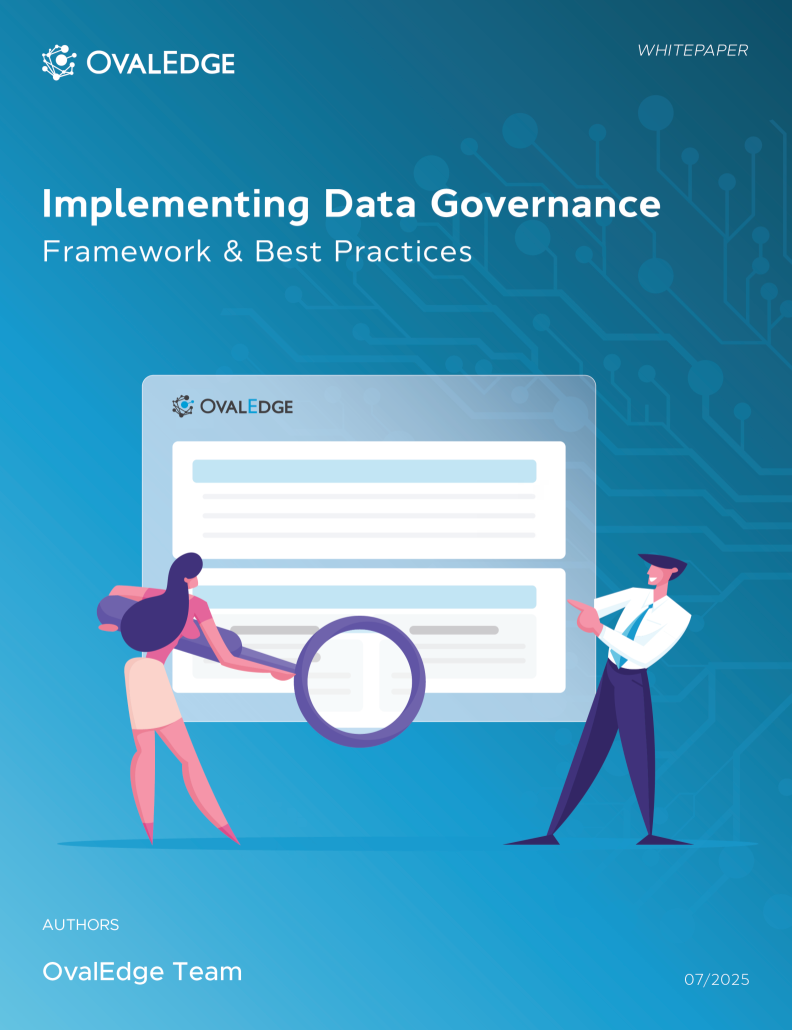Table of Contents
What is a Data Dictionary? Key Components, Benefits, & Creation Guide
At this point, it’s cliche to emphasize the importance of data nowadays. Nearly every business relies heavily on data, and people are increasingly aware and protective of the data companies store.
But data is only as valuable as how well it’s understood and used by those within the company.
Without a common understanding of your data, it’s impossible for teams to effectively collaborate, analyze, or standardize the data you’ve got stored.
This is why a data dictionary is such an important tool.
In this article, we will cover:
- What is a data dictionary?
- The importance of data dictionary in a business
- Components of a data dictionary
- How to create a data dictionary
- Benefits of using a data dictionary
Enhance your data dictionary with curated knowledge, streamline collaboration, and revolutionize data management. Schedule a Customized Demo now and unlock OvalEdge's potential!
What is a Data Dictionary?
A data dictionary is essentially a document or set of documents that outlines the data elements, their definitions, and the characteristics within a database or data source. It serves as a centralized resource for managing and documenting data, and helps ensure that data is consistent, accurate, and complete.
In a business, a data dictionary can help teams collaborate, analyze, and standardize data effectively. It provides clear definitions and rules for data entry and management, which helps ensure that data is consistent and accurate across different systems and applications.
The components of a data dictionary include data element names, definitions, data types, and any constraints or rules associated with the data.
To create a data dictionary, one must identify the data elements and their characteristics, then document them in a standardized format.
Benefits of using a data dictionary in your business
A data dictionary is a fundamental tool for businesses dealing with large amounts of data. It helps ensure that employees across different departments have a common understanding of the data they are working with, which facilitates collaboration, analysis, and standardization of data.
Without a data dictionary, it can be difficult for employees to understand the structure and relationships of data within a database or information system.
This lack of transparency can lead to confusion and errors, making it challenging for businesses to make well-informed decisions based on their data.
On top of this, a data dictionary can help improve data quality and accuracy by providing clear definitions and rules for data entry and management.
This ensures that data is consistent and accurate across different systems and applications, which is essential for businesses that rely heavily on data to make decisions.
Related: Building a Business Glossary - Why and How
Here’s a summary of the different benefits:
- Helps ensure that data is accurate, consistent, and complete, which improves data quality
- By providing a standardized view of data across an organization, a data dictionary can increase efficiency and reduce errors
- A data dictionary helps establish clear rules and standards for data use, which improves data governance
- Provides a common language and understanding of data, helping to improve collaboration between teams and departments
- A data dictionary helps ensure that data is compliant with regulatory requirements and internal policies, which can simplify compliance efforts
- You end up with accurate and consistent data, enabling better decision-making and more informed insights
Related: Data Catalog vs Data Dictionary - Differences & Use Cases
Components of a data dictionary
The contents and structure of your data dictionary will vary from company to company, depending on the different needs and requirements of each organization.
But many common components are valuable to most businesses:
- Data element names: The names of the data elements should be clear and descriptive to ensure that all users can easily understand them.
- Data element definitions: Clear and concise definitions for each data element that describe its purpose and meaning.
- Data element attributes: Additional characteristics of the data elements, such as data type, length, format, precision, and scale.
- Metadata: Additional information about the data elements, including their creator, creation date, and usage.
- Relationships: Information on how the data elements are related, such as parent-child relationships or many-to-many relationships.
- Data owner and steward information: Who is responsible for the data elements, including data owners and data stewards.
- Business rules: Rules and constraints for the data elements, including mandatory fields, allowable values, and formatting requirements.
- Data usage information: How data elements are used within the organization. This includes details on which systems or applications use them and how they are used.
- Data source information: Information about the sources of the data, including where it was collected, how it was collected, and how often it is updated.
- Glossary: A list of terms and definitions related to data elements. It is intended to ensure consistency and understanding across the organization.
Related: What is Active Metadata Management? Definition & Benefits
How to create a data dictionary
As we mentioned before, every company’s data dictionary will be different. But by following this step-by-step guide, you’ll be able to implement the key foundations you need.
Step 1: Identify data elements
Start by identifying all the relevant data elements for your organization or system. This could include information about customers, products, transactions, or any other data critical to your business.
Step 2: Define each data element and assign attributes
After identifying the data elements, define each one by creating a clear and concise definition that describes its purpose and meaning. Then, assign attributes to each data element, such as data type, length, format, precision, and scale.
This will help ensure the data is accurate and consistent across all systems and applications.
Step 3: Document relationships and define business rules
Next, document the relationships between the data elements. This includes parent-child relationships, many-to-many relationships, and any other relevant relationships. After that, define any business rules and constraints that apply to the data elements.
These may include mandatory fields, allowable values, and formatting requirements. By doing so, you can help ensure that the data is valid and conforms to the organization's standards.
Step 4: Capture metadata, source information, and usage information
It is important to capture metadata for each data element, including information such as who created it, when it was created, and its usage. Additionally, recording information about the sources of the data - such as where it was collected, how it was collected, and how often it is updated - can help ensure that the data is trustworthy and relied upon.
Step 5: Assign data owners and stewards
Assign data owners and data stewards for each data element to ensure that someone is responsible for maintaining its accuracy and completeness.
Data owners are responsible for ensuring the data is accurate and meets the organization's standards, while data stewards are responsible for managing the data on a day-to-day basis.
Related: Data Governance & Data Stewardship Explained
Step 6: Publish
After completing the data dictionary, publish it and make it available to all relevant stakeholders within the organization. Be sure to maintain it regularly, updating it as needed to reflect changes in the organization or system.
This will help ensure that the data remains accurate, consistent, and well-documented.
Pro tip: Use OvalEdge to make this process easy
This process can be overwhelming if you try to do it manually. But by using a tool like OvalEdge, the whole thing can be much simpler.
OvalEdge crawls all existing data dictionaries, making the data available to end users with a graphical user interface. You can then enhance the data dictionary within OvalEdge by curating and adding domain knowledge.
This both speeds up the process and makes it much easier to invite others to access the data dictionary.
FAQs
What is a data dictionary and why is it important?
A data dictionary is a centralized document that defines and outlines the data elements, their characteristics, and relationships within a database. It ensures consistency, accuracy and helps teams understand and collaborate on data effectively across systems.
What are the key components of a data dictionary?
Key components of a data dictionary include data element names, definitions, data types, metadata, relationships, business rules, and data ownership information, all of which help in maintaining data consistency and accuracy.
How does a data dictionary improve data governance?
A data dictionary provides clear definitions, rules, and standards for managing and using data, which helps in enforcing data governance, improving data quality, and ensuring compliance with regulations.
What are the benefits of creating a data dictionary for my business?
A data dictionary helps improve data quality, consistency, and collaboration across teams, reduces errors, enhances decision-making, and simplifies compliance with regulatory standards.
How do I create a data dictionary for my organization?
To create a data dictionary, identify data elements, define each element, assign attributes, document relationships, and define business rules. Then capture metadata, source information, and assign data owners. Regular updates are essential to keep the dictionary current.
Can I automate the process of creating a data dictionary?
Yes, tools like OvalEdge can automate the process of creating a data dictionary by crawling data systems, collecting metadata, and providing an easy-to-use interface to curate and enhance the data dictionary.
How often should a data dictionary be updated?
A data dictionary should be updated regularly to reflect changes in business needs, data sources, and system updates. It's crucial to maintain it as a dynamic resource to ensure continued accuracy and relevance.
What is the difference between a data dictionary and a data catalog?
A data dictionary focuses on the structure and definition of data elements, while a data catalog provides an inventory of available data assets, including their metadata, access controls, and data lineage. Both are essential for effective data management.
What you should do now
|
OvalEdge recognized as a leader in data governance solutions
.png?width=1081&height=173&name=Forrester%201%20(1).png)
“Reference customers have repeatedly mentioned the great customer service they receive along with the support for their custom requirements, facilitating time to value. OvalEdge fits well with organizations prioritizing business user empowerment within their data governance strategy.”
.png?width=1081&height=241&name=KC%20-%20Logo%201%20(1).png)
“Reference customers have repeatedly mentioned the great customer service they receive along with the support for their custom requirements, facilitating time to value. OvalEdge fits well with organizations prioritizing business user empowerment within their data governance strategy.”
Gartner, Magic Quadrant for Data and Analytics Governance Platforms, January 2025
Gartner does not endorse any vendor, product or service depicted in its research publications, and does not advise technology users to select only those vendors with the highest ratings or other designation. Gartner research publications consist of the opinions of Gartner’s research organization and should not be construed as statements of fact. Gartner disclaims all warranties, expressed or implied, with respect to this research, including any warranties of merchantability or fitness for a particular purpose.
GARTNER and MAGIC QUADRANT are registered trademarks of Gartner, Inc. and/or its affiliates in the U.S. and internationally and are used herein with permission. All rights reserved.



.webp)


